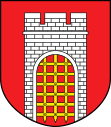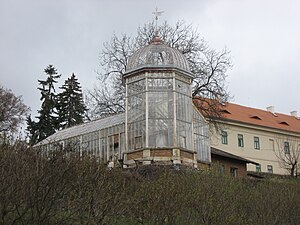Valeč v Čechách
| Valeč | ||||
|---|---|---|---|---|
|
||||
| Basic data | ||||
| State : |
|
|||
| Region : | Karlovarský kraj | |||
| District : | Karlovy Vary | |||
| Area : | 2364.594 ha | |||
| Geographic location : | 50 ° 10 ' N , 13 ° 15' E | |||
| Height: | 533 m nm | |||
| Residents : | 357 (Jan. 1, 2019) | |||
| Postal code : | 364 52 - 364 55 | |||
| License plate : | K | |||
| traffic | ||||
| Street: | Chyše - Podbořanský Rohozec | |||
| Next international airport : | Karlovy Vary Airport | |||
| structure | ||||
| Status: | local community | |||
| Districts: | 5 | |||
| administration | ||||
| Mayor : | Josef Kubař (as of 2018) | |||
| Address: | Náměstí 119 364 55 Valeč |
|||
| Municipality number: | 555690 | |||
| Website : | www.valec.cz | |||
| Location of Valeč in the Karlovy Vary district | ||||

|
||||
Valeč (German Waltsch ) is a municipality in the Czech Republic . It is located twelve kilometers northeast of Žlutice and belongs to the Okres Karlovy Vary . The historic city center of the baroque town of Valeč has been declared an urban conservation area.
geography
Valeč is located at the southeastern foot of the Duppau Mountains on the Mlýnecký creek ( Filirschbach ). In the north, the place borders directly on the Hradiště military training area . To the west - already in the military area - are the remains of Neuhaus Castle; in the northeast is the ruins of the Lina Fortress. To the northwest rises the Prokopy ( Prokopberg , 748 m), in the northeast lies the Jedliny ( Hohe Tanne , 701 m) and in the west the Šibeniční vrch ( Galgenberg , 618 m).
Neighboring towns are Ořkov, Nová Ves and Dětaň in the northeast, Vrbička in the east, Skytaly and Kamýk in the southeast, Jeřeň in the south, Vrbice and Bělá in the southwest and Malý Hlavákov in the west.
Mineralogical site
The hyalite ( opal ) from the area around Valeč is known worldwide for its characteristic formation.
history
The settlement Válek, whose name derives from the name Valentin, was probably established in the first half of the 13th century. The castle and settlement of the same name, owned by the brothers Ctibor and Beneš von Válek, has been recorded in writing since 1358. They were followed by the Lords of Steben and, from 1371, Borso von Osek . Beneš von Buškovice owned the castle from 1377 to 1416. After that the Lords of Duppau became owners of Waltsch. From 1516 Jakub Kyšperský von Vřesovice owned the rule, who had the castle rebuilt. In 1514, Vladislav II gave Valeč city rights.
After Jan Kyšperský of Vřesovice fell in the Battle of Mohács in 1526 , his heirs sold the rule to Hugo von Leiseneck. From this in 1538 Wilhelm Lobkowicz von Hassenstein acquired the goods.
From 1570 Christoph von Steinbach was master of Waltsch. His son Wenceslaus had the castle rebuilt in the Renaissance style in 1585. After the Battle of the White Mountain , Wenceslas von Steinbach's goods were confiscated and he had to flee Bohemia. The following year, Barbara Steinbach von Pauten, from the Catholic branch of the family, bought the castle. Under their descendant Johann Christoph Kager von Steinbach, who acquired the rule in 1694, the baroque renovation of the castle began. The renovation was carried out initially under the direction of Francesco Barelli and then by Antonio Bianno Rossa. After his death in 1723 Johann Christoph Tyll from Lochotín continued the work. The lord of the castle also died during the renovation in 1721. His son Johann Ferdinand Kager von Globen had the work completed and renewed renovations carried out between 1730 and 1733. After his death in 1745 Josef August Kager from Globen and Limburg-Styrum inherited the property. His daughter Marie Josefa, widowed Countess of Argentau d'Ochain, sold the Waltsch estate to Johann Anton Pergen von Pergen in 1797. In the course of this, she ceded a still unpaid debt claim by the sculptor Matthias Bernhard Braun, who died in 1738, for the impressive sum of 810 guilders and 54 Kreutzers.
As early as 1798, the manor was sold again. Johann Gottfried Korb von Weidenheim became the new owner. His grandson Karl had the castle redesigned in the neo-Renaissance style in 1847.
After the abolition of patrimonial rule, the political municipality Waltsch / Valeč in the Žlutice / Luditz district was established in 1850. In 1890 the Korb von Weidenheim sold the goods in Waltsch to Count Vinzenz von Thurn-Valsassina. In 1937 she was acquired by Dr. Johann Graf Larisch-Mönnich.
The market town of Waltsch had 807 inhabitants in 1930. After the Munich Agreement , Waltsch was added to the German Reich in 1938 and until 1945 the market belonged to the Luditz district . In 1939 Waltsch had 730 inhabitants. After the end of the war, Valeč came back to Czechoslovakia and was classified in the Okres Podbořany in 1946. The status as a minority town was not renewed. Johann Graf Larisch-Mönnich was expropriated by the Beneš decrees in 1945. Since 1961 Vrbice belongs to the Okres Karlovy Vary. In the same year Jeřeň and 1975 Vrbice and Kostrčany with Nahořečice and Velký Hlavákov, which had previously belonged to Luka, were incorporated. In 1976 the castle burned out. Since 1990 Vrbice has been independent again. In 1995 and 1996 the exterior facade of the castle was restored.
Community structure
The municipality Valeč consists of the districts Jeřeň ( Girschen ), Kostrčany ( Kosterschan ), Nahořečice ( Nahoretitz ), Valeč ( Waltsch ) and Velký Hlavákov ( Großlubigau ), which also form cadastral districts. The settlement of Bělá ( Biela ) also belongs to Valeč .
Partner communities
- Drebach , Germany
- Neckargemünd , Germany
- Valeč , Czech Republic
Attractions
- Valeč Castle; the castle, which was built from the castle around 1526, was later redesigned several times in the styles of the Renaissance, Baroque and Neo-Baroque styles. The sculptural work comes from Matthias Bernhard Braun . After the Second World War, the two-tower castle served as a boarding school for apprentices. It burned out on April 2, 1976. It remained ruinous and secured with an emergency roof until the 1990s, after which it was restored from 1995.
- Historical greenhouse; the structure with a cast steel dome was restored in 1996.
- Church of the Nativity of John the Baptist; the former burial chapel of the Steinbachers from the 17th century was redesigned in Baroque style by the builder Bianno Rossa. At the end of the 19th century, the neo-baroque renovation took place. The church with its massive tower with a high dome is one of the landmarks of Valeč, along with the castle.
- Baroque Church of St. Trinity, built 1710–1720 by the house architect of the Steinbach family, Giovanni Antonio Bianno Rossa
- Statue of St. John of Nepomuk
- Marian column
- Sporck statue, created in 1733 by Anton Braun, a nephew of Matthias Bernhard Braun
- Trinity column, erected by order of Johann Ferdinand Kager Globes according to the last will of his wife. The column , built according to plans by Franz Maximilian Kaňka , was created in 1730 by Anton Braun
- Amphitheater, built at the end of the 19th century
- Propylaea in the castle garden
- Baroque house of the castle chaplain , built in 1701
- Baroque cemetery chapel of the Sorrowful Virgin Mary, built in 1751
- Old school
- Obelisk in the castle park; made of red sandstone, with subsequent, handcrafted name engravings, as well as Korean characters and names with the year date 1956 on the north side, during the Korean War, war children from North Korea were housed in the castle.
Individual evidence
- ↑ http://www.uir.cz/obec/555690/Valec
- ↑ Český statistický úřad - The population of the Czech municipalities as of January 1, 2019 (PDF; 7.4 MiB)
- ↑ http://www.uir.cz/casti-obce-obec/555690/Obec-Valec
- ↑ http://www.uir.cz/katastralni-uzemi-obec/555690/Obec-Valec
- ↑ "Barockstädtchen Waltsch", tourism brochure 3/14, German-Czech, there: History-Chronology page 6 "1953–1956".










